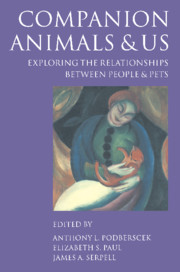Book contents
11 - The influence of current relationships upon pet animal acquisition
from Part III - Pets, families and interactions
Summary
INTRODUCTION
Deciding to obtain a pet animal constitutes a lifestyle change with far-reaching effects. The animal is likely to become a feature of a person's life for several years. This leads to the question of what is it about an individual's current life circumstances that promotes an impulse to contemplate pet ownership?
It seems likely that individuals who are in some way dissatisfied with their present life circumstances may experience motivation to alter this situation. This intuitive hypothesis has been formalized by Jungermann (1980) as the role of possibility of continuity in personal decision making. This refers to the prediction that an individual is not likely to decide upon a course of action if the maintenance of the status quo is a satisfactory option. However, if the continuation of current circumstances is not desirable, some course of action will be taken. Obtaining a pet may be one such course of action to deal with problematic life circumstances. This argument leads to a further question: what kind of change in an individual's lifestyle does the introduction of a pet imply?
PETS AS RELATIONAL PARTNERS
It is plausible that introducing a pet animal into a household constitutes an opportunity to form a new relationship. Many owners of pet animals appear to enter into some form of relationship with their pet, analogous to human–human relationships. Hirschmann (1994) argues that the most common role a pet animal can fulfil is that of a friend or companion to its owner. Pet animals are also frequently described as family members (Voith, 1985), or even as surrogate siblings or children (Sanders, 1990; Hirschmann, 1994).
The fact that some individuals view their pet animals as relational partners is a necessary but not sufficient criterion for classifying the interaction between humans and pets as relationship-like. Before deciding whether human–pet associations can be considered as relationships, the term relationship needs clarification. Finding a single definition of a relationship is a difficult task. Research in the field of social relationships tends to be fragmented. Individual types of relationship (e.g. marital, parental, fraternal, friendship) are usually examined as separate entities. Researchers tend to concentrate upon one particular relationship type which interests them, at the expense of examining other relationship structures (Fiske, 1992; Berscheid, 1995). A consequence of this is the absence of a generic perspective on relationships, applicable to all individual instances.
- Type
- Chapter
- Information
- Companion Animals and UsExploring the relationships between people and pets, pp. 189 - 208Publisher: Cambridge University PressPrint publication year: 2000



